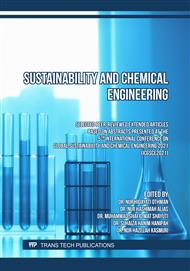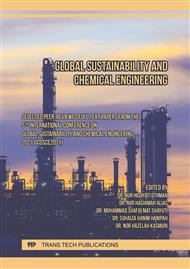[1]
A. Mancini et al., Biological and Nutritional Properties of Palm Oil and Palmitic Acid: Effects on Health,, Molecules, vol. 20, no. 9, p.17339–17361, 2015,.
DOI: 10.3390/molecules200917339
Google Scholar
[2]
E. T. Phuah, O. M. Lai, T. S. Y. Choong, C. P. Tan, and S. K. Lo, Kinetic Study on Partial Hydrolysis of Palm Oil Catalyzed by Rhizomucor miehei Lipase,, J. Mol. Catal. B Enzym., vol. 78, p.91–97, 2012,.
DOI: 10.1016/j.molcatb.2012.03.009
Google Scholar
[3]
S. O. Lai, S. L. Heng, K. C. Chong, and W. J. Lau, Deacidification of Palm Oil Using Solvent Extraction Integrated With Membrane Technology,, J. Teknol., vol. 78, no. 12, p.69–74, 2016,.
DOI: 10.11113/jt.v78.10069
Google Scholar
[4]
G. Carta, E. Murru, S. Banni, and C. Manca, Palmitic Acid: Physiological Role, Metabolism and Nutritional Implications,, Front. Physiol., vol. 8, no. NOV, p.1–14, 2017,.
DOI: 10.3389/fphys.2017.00902
Google Scholar
[5]
O. B. Imoisi, G. E. Ilori, I. Agho, and J. O. Ekhator, Palm Oil, Its Nutritional and Health Implications (Review),, J. Appl. Sci. Environ. Manag., vol. 19, no. 1, p.127, 2015,.
DOI: 10.4314/jasem.v19i1.17
Google Scholar
[6]
Zakwan, E. Julianti, and Z. Lubis, Production Mono-diglyceride (MDG) From Refined Deodorized Palm Oil (RBDPO) by Enzymatic Process,, Int. Food Res. J., vol. 24, no. 1, p.56–59, (2017).
DOI: 10.1088/1755-1315/977/1/012085
Google Scholar
[7]
C. B. Goncalves, C. E. C. Rodrigues, E. C. Marcon, and A. J. A. Meirelles, Deacidification of Palm Oil by Solvent Extraction,, Sep. Purif. Technol., vol. 160, p.106–111, 2016,.
DOI: 10.1016/j.seppur.2016.01.016
Google Scholar
[8]
S. M. Silva et al., Adsorption of Carotenes and Phosphorus From Palm Oil Onto Acid Activated Bleaching Earth: Equilibrium, Kinetics and Thermodynamics,, J. Food Eng., vol. 118, no. 4, p.341–349, 2013,.
DOI: 10.1016/j.jfoodeng.2013.04.026
Google Scholar
[9]
M. Bahadi, A. A.-W. Japir, N. Salih, and J. Salimon, Free Fatty Acids Separation From Malaysian High Free Fatty Acid Crude Palm Oil Using Molecular Distillation,, Malaysian J. Anal. Sci., no. May, p.1042–1051, (2016).
DOI: 10.17576/mjas-2016-2005-08
Google Scholar
[10]
MPOB, Palm Oil - Specification MS 814:2007,, vol. 814. p.1–14, (2007).
Google Scholar
[11]
A. H. Riyadi, T. R. Muchtadi, N. Andarwulan, and T. Haryati, Pilot Plant Study of Red Palm Oil Deodorization Using Moderate Temperature,, Agric. Agric. Sci. Procedia, vol. 9, p.209–216, 2016,.
DOI: 10.1016/j.aaspro.2016.02.129
Google Scholar
[12]
R. A. Azmi et al., Deacidification of Crude Palm Oil Using PVA-crosslinked PVDF Membrane,, J. Food Eng., vol. 166, p.165–173, 2015,.
DOI: 10.1016/j.jfoodeng.2015.06.001
Google Scholar
[13]
AOCS, Official Method and Recommended Practices of the American Oil Chemists' Society (AOCS) Ce 1h-05 Determination of Cis-, Trans-, Saturated, Monounsaturated and Polyunsaturated Fatty Acids in Vegetable or Non-ruminant Animal Oils and Fats by Capillary GLC., p.1–29, (2017).
DOI: 10.1007/s11746-006-1230-y
Google Scholar
[14]
AOCS, Official Method and Recommended Practices of the American Oil Chemists' Society (AOCS) Ca 5a-40 Free Fatty Acids," Official Methods and Recommended Practices of the American Oil Chemists, Society, no. Sampling and analysis of commercial fats and oils AOCS. p.1–2, (2017).
DOI: 10.1002/lipi.19970990510
Google Scholar
[15]
M. Taufik, H. N. Lioe, and N. D. Yuliana, Evaluation of Major Fatty Acids Determination in Palm Oil by Gas Chromatography-Flame Ionization Detection,, J. Agritech, vol. 36, no. 03, p.308, 2016,.
DOI: 10.22146/agritech.16603
Google Scholar
[16]
C. Montoya et al., Genetic Architecture of Palm Oil Fatty Acid Composition in Cultivated Oil Palm (ElaeisguineensisJacq.) Compared to Its Wild Relative E. oleifera (H.B.K) Corte´s Carmenza,, PLoS One, vol. 9, no. 5, 2014,.
DOI: 10.1371/journal.pone.0101628
Google Scholar
[17]
P. Hariyadi, Menngenal Minyak Sawit Dengan Beberapa Karakter Unggulnya., p.1–22, (2014).
Google Scholar
[18]
P. K. Prasanth Kumar and A. G. Gopala Krishna, Physico-chemical Characteristics and Nutraceutical Distribution of Crude Palm Oil and Its Fractions,, Grasas y Aceites, vol. 65, no. 2, 2014,.
DOI: 10.3989/gya.097413
Google Scholar
[19]
A. A.-W. Japir, J. Salimon, D. Derawi, M. Bahadi, S. Al-Shuja'A, and M. R. Yusop, Physicochemical Characteristics of High Free Fatty Acid Crude Palm Oil,, Oilseeds fats, Crop. Lipids, vol. 24, no. 5, p.1–9, 2017,.
DOI: 10.1051/ocl/2017033
Google Scholar
[20]
D. T. de Almeida, T. V. Viana, M. M. Costa, C. de S. Silva, and S. Feitosa, Effects of Different Storage Conditions on the Oxidative Stability of Crude and Refined Palm Oil, Olein and Stearin (Elaeis guineensis),, Food Sci. Technol., vol. 39, p.211–217, 2019,.
DOI: 10.1590/fst.43317
Google Scholar
[21]
R. O. Akinyeye, E. I. Adeyeye, O. Fasakin, and A. Agboola, Physico-chemical Properties and Anti-nutritional Factors of Palm Fruit Products (Elaeis guineensis Jacq.) From Ekiti State Nigeria,, Electron. J. Environ. Agric. Food Chem., vol. 10, no. 5, p.2190–2198, (2011).
Google Scholar
[22]
YCW, Quality and Specification,, Oil Palm Knowledge Base, 2014. https://oilpalmblog.wordpress.com/2014/03/29/quality-and-identity-characteristics-of-palm-oil-part-1-quality-characteristics/#respond.
Google Scholar
[23]
S. R. Ismail, S. K. Maarof, S. S. Ali, and A. Ali, Systematic Review of Palm Oil Consumption and the Risk of Cardiovascular Disease,, PLoS One, vol. 13, no. 2, p.1–16, 2018,.
DOI: 10.1371/journal.pone.0193533
Google Scholar
[24]
V. Rathore, N. Singh, and R. K. Mahat, Risk Factors of Acute Myocardial Infarction: A Review,, Eurasian J. Med. Investig., vol. 2, no. 1, p.1–7, 2018,.
Google Scholar



